Starting a garden can be a rewarding and enjoyable experience, and it doesn’t have to be complicated. By breaking the process down into manageable steps, you can start gardening at your own pace. Here are the key steps to get you started:
- Consider what you want to plant: Decide whether you want a vegetable garden, an herb garden, a flower garden, or a combination of them. Choose plants that your family will eat or be willing to try. Start small until you have a better understanding of what you’re getting into.
- Pick the right spot: Most plants require 6-8 hours of full sun each day, so observe your yard to find spots that receive adequate sunlight. Ensure easy access to a water source and consider the slope of the garden area.
- Clear the ground: Remove weeds and sod from the area you plan to plant. You can cut out the sod or use the lasagna gardening method, which involves covering the area with newspaper and compost to create a no-grass, weed-free bed.
- Test and improve your soil: Have a soil test done to understand the composition of your soil and determine if it needs any amendments. Adding organic matter like compost can improve the quality of the soil.
- Prepare your planting beds: Loosen the soil in your beds to make it easier for roots to grow and access water and nutrients. Dig or till the soil while it’s moist enough to form a loose ball but dry enough to fall apart.
- Choose your plants: Select plants that are adapted to your climate, soil, and sunlight conditions. Consider starting with easy-to-grow plants like calendula, geraniums, cucumbers, and lettuce.
- Start planting: Follow planting instructions for each plant, considering the depth and spacing requirements. You can sow seeds directly in the garden or buy young plants to transplant.
- Water at the right time: Provide adequate water for your newly planted garden. Pay attention to the moisture needs of each plant and adjust your watering schedule accordingly.
By following these easy steps, you can start your garden and enjoy the rewards of homegrown produce and beautiful blooms. Remember to spend time in your garden, observe and address any issues, and embrace the joy of harvesting and eating what you grow. Happy gardening!
Key Takeaways
- Choose what you want to plant, and start small until you get the hang of it.
- Find a spot that has enough sunlight and easy access to water.
- Clear the ground, test and improve your soil, and prepare your planting beds.
- Choose plants that are adapted to your climate, soil, and sunlight conditions.
- Follow planting instructions for each plant, considering the depth and spacing requirements.
- Water your garden adequately and pay attention to each plant’s moisture needs.
Consider What You Want to Plant
First and foremost, consider what you want to plant in your garden. Do you want to grow a bountiful vegetable garden, a fragrant herb garden, or a beautiful flower garden? Depending on your preference, choose vegetables and herbs that your family enjoys eating, and pick flowers like sunflowers or roses that match your aesthetic. When selecting vegetable varieties, consider the climate, soil, and water conditions in your area to ensure the best possible harvest.
Annuals and perennials are two types of flowers to consider. Annuals are plants that complete their life cycle in one growing season and need to be replanted each year. They offer a wide range of colors and blooms and are perfect for adding quick pops of color to your garden. Perennials, on the other hand, come back year after year and offer a more permanent element to your garden. Before selecting flowers, consider the maintenance requirements of each type. Do you want to spend time deadheading spent blooms or pruning back overgrown foliage?
Choose a Suitable Location
Next, choose a location for your garden that receives 6-8 hours of full sun each day and has easy access to water. This is crucial for plant growth and health. Vegetables, herbs, and flowers have different maintenance requirements, so consider what you want to plant and pick a spot accordingly. If you’re a beginner, start small until you have a better understanding of your garden’s needs.
Garden essentials include the amount of sunlight, water, and soil quality in a specific area. Full sun means that the area should receive direct sunlight for six or more hours. Consider this when selecting your garden space. You want to make sure the sun reaches your plants, as this is crucial for photosynthesis. It’s also essential to have easy access to a water source to ensure your garden stays hydrated. This can be a sprinkler system, hose, or watering can.
Clear the ground by removing weeds and sod, either by cutting it out or using the lasagna gardening method. The lasagna gardening method involves layering materials such as newspaper, compost, straw, and leaves on top of the soil. This method eliminates the need for tilling, making it an ideal option for those who want to avoid disturbing the soil’s ecosystem.
Test and improve your soil by having a soil test done or using a DIY kit to determine its nutrient levels. Soil pH levels and nutrient contents can vary, so it’s essential to test your soil’s quality before planting. You can buy soil test kits online or at a local garden store for a quick and easy solution. Add organic matter, such as compost, to improve the soil’s quality. This will help plants grow stronger and healthier by providing essential nutrients.
Prepare your planting beds by loosening the soil, either by tilling or digging, and mixing in the organic matter. This will aid in better water and nutrient absorption for the plants. You can also create raised garden beds if the area you’ve chosen has poor soil quality. This way, you have more control over the soil’s quality and ensure plant success.
Prepare the Ground
Before you start planting, it’s essential to clear the ground by removing any weeds and sod. You can also use the lasagna gardening method as an alternative to traditional clearings. This method involves layering newspaper or cardboard over the area, adding compost, and allowing it to decompose over time, creating a healthy planting bed.
| Steps to Prepare the Ground for Your Garden |
|---|
| Clear the ground by digging up weeds and sod from the area where you plan to plant your garden. |
| Alternatively, you can use the lasagna gardening method, which involves layering newspaper or cardboard, adding compost, and allowing it to decompose over time. |
| Get a soil test done to determine nutrient levels and pH. This test will provide information about any added nutrients or adjustments required for optimal plant growth. |
| Add organic matter, such as compost, to your soil before planting to improve its fertility, structure, and the drainage capabilities. |
With the ground cleared and prepared, it’s time to start planting. Follow the steps outlined to ensure successful plant growth for your garden.
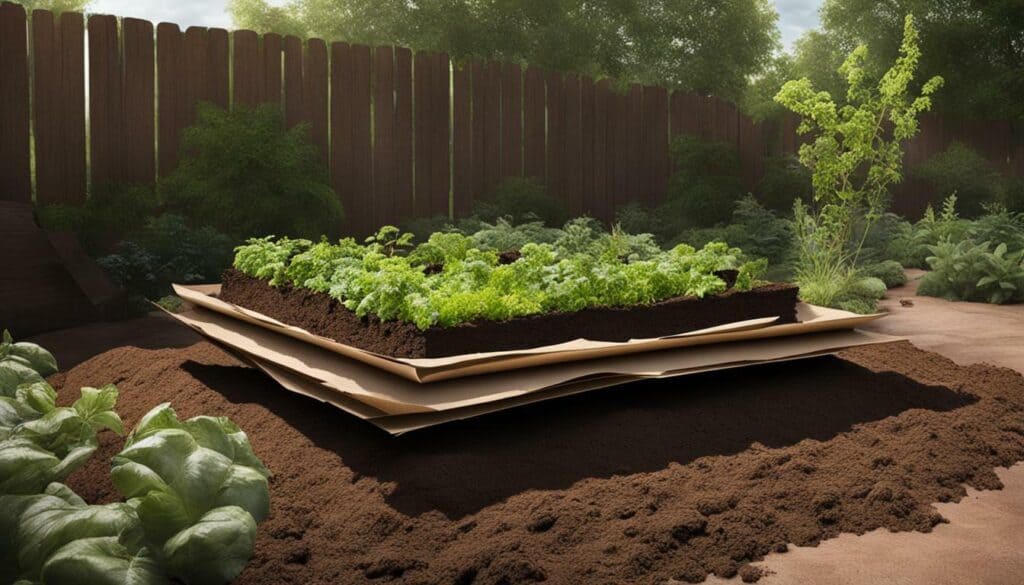
By following these steps, you can set a strong foundation for a successful garden that will offer beauty, joy, and delicious produce to harvest.
Test and Improve the Soil
Once the ground is cleared, it’s time to test and improve your soil to ensure healthy plant growth. The only way to know what nutrients your soil is lacking is to get a soil test done. Sending a soil sample to your county cooperative extension office is the most accurate way to test soil, but if you’re short on time or budget, a DIY kit can provide a general idea of your soil’s nutrient levels.
If the soil test shows that you have nutrient deficiencies, adding organic matter is the solution. Organic matter is any decomposed plant or animal material such as compost, leaf mold, or aged manure. Adding organic matter to your soil can improve soil structure, boost nutrient levels, and help with drainage and compaction issues. Spread a 3-4 inch layer of organic matter over your garden bed and work it into the soil with a garden fork or tiller.
It’s important to note that adding too much organic matter can be as harmful as adding too little. A good rule of thumb is to add no more than 20-30% of organic matter to your soil. If you’re unsure how much to add, get a soil test recommendation or consult with a gardening expert.
Compost is a great source of organic matter that is readily available. You can make compost at home by collecting yard waste, such as leaves, grass clippings, and twigs, and food scraps, such as fruit and vegetable trimmings and coffee grounds. Mix these materials in a compost bin or pile and let nature do its job. You can also purchase bags of compost at your local nursery or garden center.
Testing and improving your soil is a crucial step in having a successful garden. Take the time to do it right, and you’ll be rewarded with healthy and fruitful plants.
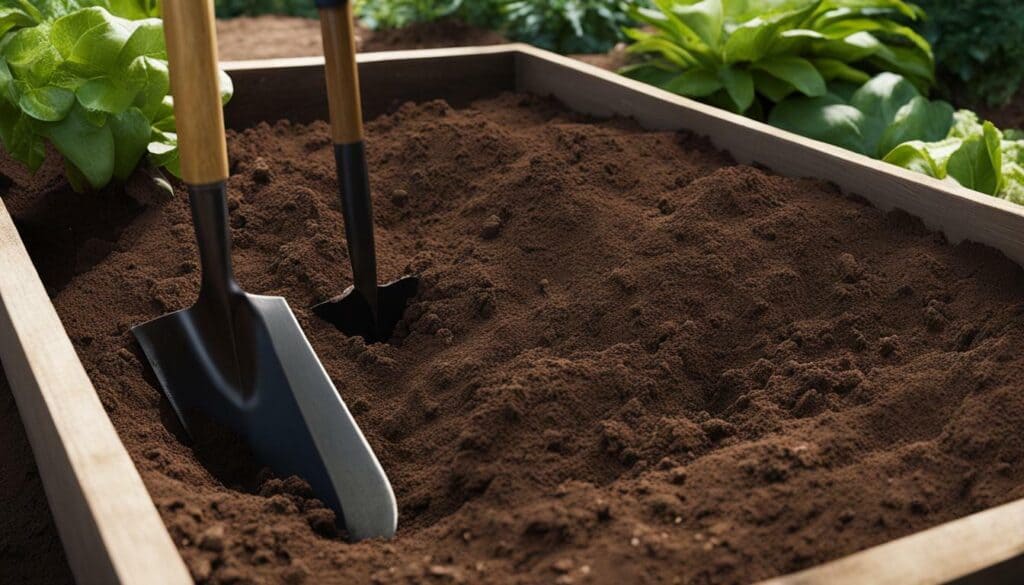
Prepare the Planting Beds
To create optimal conditions for your plants, prepare the planting beds by tilling or digging the soil and mixing in organic matter. First, consider what you want to plant and choose the best spot for your garden. Once you have identified the area, clear the ground of weeds and sod using the lasagna gardening method or manually cutting them out.
Get your soil tested to determine its nutrient levels and any deficiencies. You can then add organic matter, such as compost, to improve its fertility and drainage.
Next, prepare your planting beds by loosening the soil using either tilling with a mechanical device or digging by hand. Mix in organic matter during this process and avoid compacting the soil by walking on the beds.
Now that you have prepared the planting beds, it’s time to pick your plants. Consider plants that are suitable for your climate, soil, and sunlight conditions. Easy-to-grow plants for beginners include calendula, cosmos, cucumbers, and tomatoes.
Follow the planting instructions provided by the seeds or plants you’ve chosen. Plant seeds at the appropriate depth and spacing, and ensure they receive adequate water and sunlight.
Remember to water your garden regularly, paying attention to the specific needs of each plant. Newly planted seeds and seedlings should be kept moist, but avoid overwatering to prevent rot.
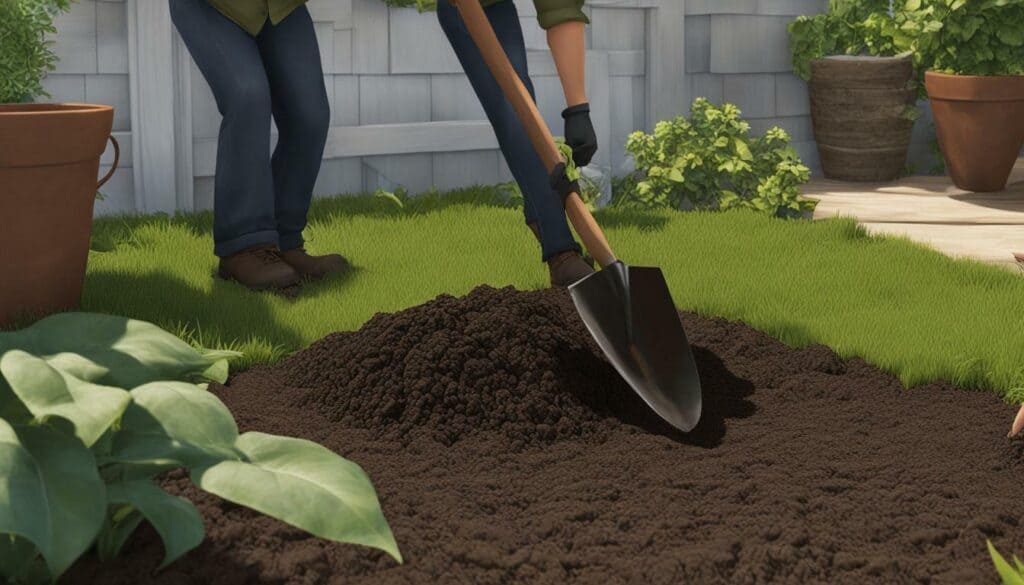
By following these steps, you can effectively prepare your planting beds and establish a successful garden. Enjoy the process of gardening and reap the rewards of fresh produce and beautiful blooms.
Choose and Plant Your Plants
Now comes the exciting part – choosing the plants you want to grow and planting them in your garden. When deciding what to plant, consider what type of garden you want to have and choose plants that are well-suited to your climate and maintenance preferences. Whether you’re interested in growing annuals, perennials, or vegetables, there are plenty of options to choose from.
| Plant Type | Description |
|---|---|
| Annuals | Annuals are plants that complete their life cycle in one season. They are great for adding color to your garden and can be easy to grow from seed. |
| Perennials | Perennials are plants that come back year after year. They can be a bit more challenging to grow, but once established, they require less maintenance than annuals. |
| Vegetables | Vegetables are a popular choice for many gardeners. They can be grown in a variety of shapes and sizes and provide a delicious and healthy addition to your diet. |
When choosing your plants, be sure to read the seed packet or plant tag carefully to ensure that they are adapted to your climate, soil, and sunlight conditions. Look for easy-to-grow plants for beginners, such as calendula, geraniums, and cucumbers. Consider starting seeds indoors before the last frost date or transplanting young plants into your prepared beds.
Once you have chosen your plants, it’s time to start planting. Follow the planting instructions provided by the seed packet or nursery. Make sure you give each plant enough space to grow and thrive, and consider using plant supports for larger plants to help keep them upright. Water your plants regularly, especially during the early stages of growth, and be mindful of their water needs.
With a little bit of planning and effort, you can choose and plant the perfect plants for your garden. Enjoy the process and the rewards of your efforts with fresh produce, fragrant flowers, or both!
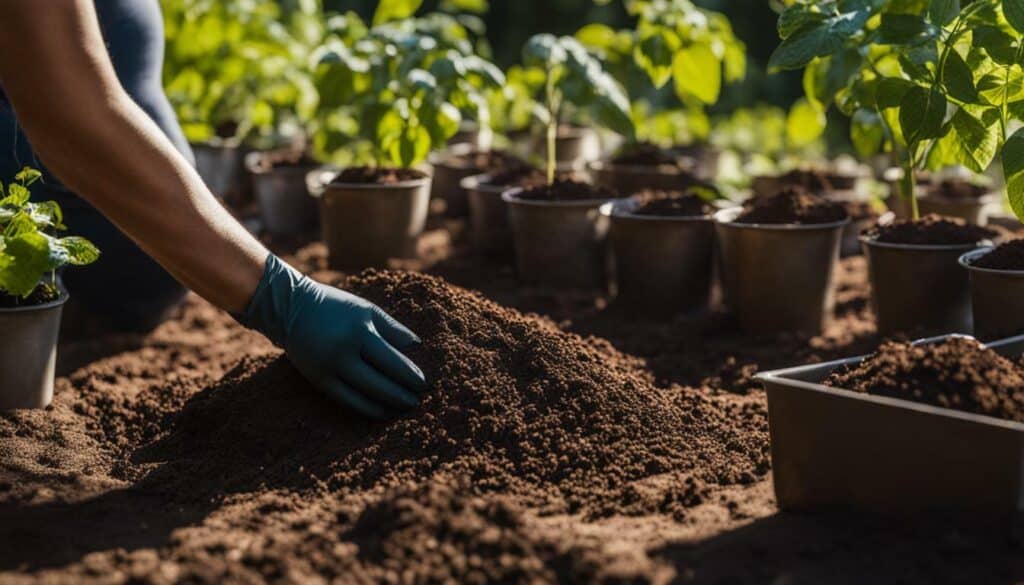
Water Your Garden
One of the key factors in maintaining a healthy garden is watering it at the right time and in the right way. It is essential to consider the specific needs of each plant when it comes to watering.
Most plants require a consistent moisture level in the soil, with some needing more water than others. Water your garden in the early morning or late evening to reduce water loss through evaporation. Avoid watering in the middle of the day when the sun is at its strongest, which can scorch your plants and damage their leaves.
It is important to ensure that the water reaches the roots of the plants. Avoid overhead watering, which can promote the spread of fungal diseases and waste water. Instead, use a watering can or a drip irrigation system, directing the water at the base of the plant.
Always check the moisture level of the soil before watering your plants. Stick your finger about an inch into the soil to determine if it feels dry or damp. If the soil feels dry, it is time to water your plants. If it feels damp, wait a day or two and check again.
Regularly monitor your garden for any signs of under or overwatering. Drooping leaves or yellowing leaves can indicate that your plants are not receiving enough water, while wilted leaves or mold growth can indicate overwatering. Adjust your watering schedule accordingly, and ensure that your plants receive just the right amount of water to keep them healthy.
By following these watering tips and keeping a regular maintenance schedule, your garden will thrive and produce a bountiful harvest.
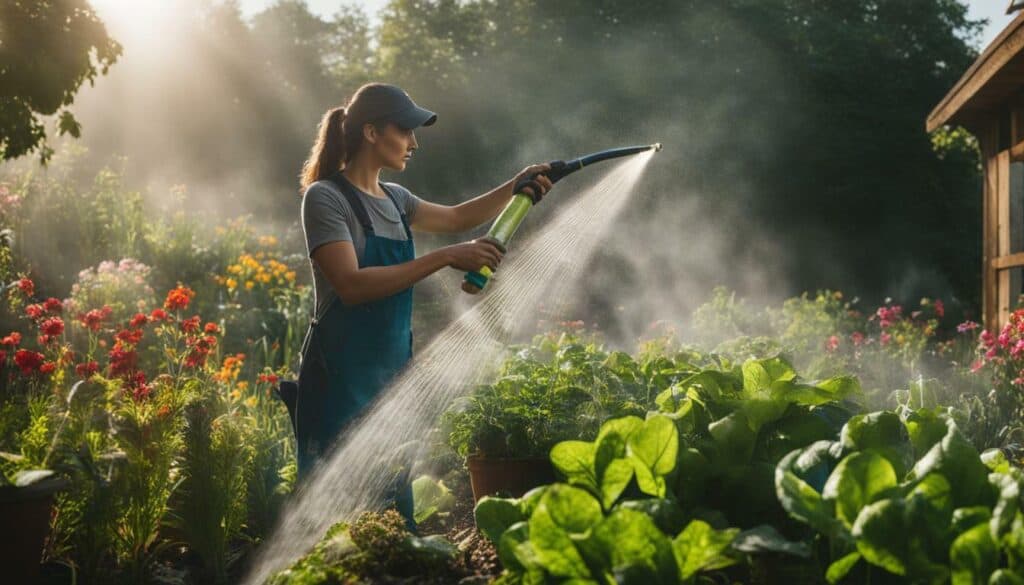
Maintain Your Garden
To keep your garden thriving, regular maintenance is essential. Here are eight simple steps to help you maintain your garden:
- Keep up with weeding: Pull weeds regularly to prevent competition for nutrients and water. Use mulch to suppress weed growth and retain moisture in the soil.
- Check for pests: Inspect your plants regularly for signs of pests or diseases. Remove affected leaves or plants and consider using organic pest control methods.
- Water as needed: Use a moisture meter or stick your finger in the soil to determine the need for watering. Water in the morning or evening to avoid evaporation and water stress on your plants.
- Fertilize: Apply a balanced fertilizer to your garden periodically throughout the growing season. Be sure to follow the manufacturer’s instructions and avoid over-fertilization.
- Prune: Remove dead or damaged branches and stems from your plants to encourage healthy growth. Prune back herbs to prevent flowering and encourage new leaf growth.
- Harvest regularly: Pick vegetables and herbs as they ripen to encourage continued production. This also prevents the plants from becoming overripe or attracting pests.
- Clean up: Remove dead plant material and debris from your garden regularly. This prevents the buildup of disease and pests and keeps your garden looking tidy.
- Monitor soil health: Test your soil regularly to ensure proper pH balance and nutrient levels. Amend the soil as needed with compost or other organic matter.
By following these simple steps, you can successfully maintain your garden and enjoy its beauty and productivity for years to come.
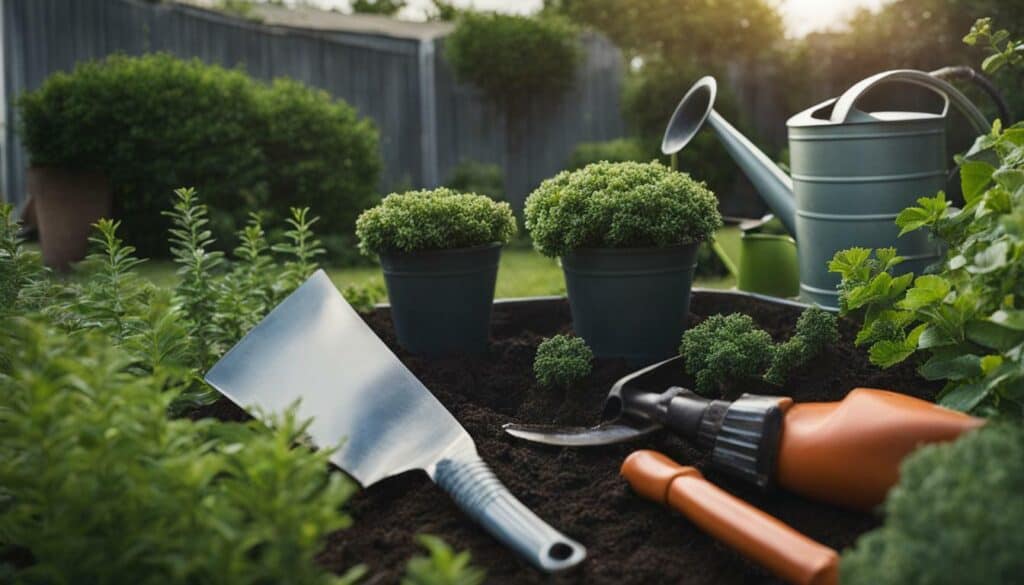
Conclusion
By following these easy steps to plant a garden, you’ll be well on your way to creating a breathtaking oasis in your own backyard! As a beginner, it’s essential to consider what you want to plant, choosing from a variety of options like vegetables, herbs, or perennials. Once you’ve selected your plants, it’s crucial to find the best location for your garden, ensuring it receives adequate sunlight and easy access to water.
Next, prepare the ground by clearing any weeds or using the innovative lasagna gardening method. Testing and improving the soil is also important to ensure your plants are receiving the necessary nutrients. Tilling or digging the soil and incorporating organic matter like compost can create the perfect planting bed.
Choosing and planting your plants are also important steps. Selecting the right plant varieties for your climate and ensuring they are planted correctly, according to instructions, can make all the difference. Once planted, regular watering and care are crucial to the growth of your garden, so be sure to take the time to observe and address any issues that may arise.
Finally, the ultimate reward is harvesting and enjoying the fruits of your labor. With a little care and attention, you can have a successful garden that provides fresh produce or beautiful flowers for your enjoyment. Keep these beginner gardening steps in mind, and you’ll be amazed at what you can achieve!
FAQ
Q: What should I consider when deciding what to plant in my garden?
A: Consider whether you want to plant vegetables, herbs, or flowers. Think about your preferences, available space, and gardening goals.
Q: How important is choosing a suitable location for my garden?
A: It is crucial to choose a spot that receives 6-8 hours of full sun each day and has easy access to water. These factors will greatly impact the success of your garden.
Q: What is the lasagna gardening method?
A: The lasagna gardening method involves layering newspaper and compost to create a new planting bed. It helps smother weeds and improves the soil over time.
Q: Why is it important to test and improve the soil?
A: Testing the soil allows you to determine its pH level and nutrient content. Adding organic matter like compost helps improve soil fertility and structure, promoting healthy plant growth.
Q: How should I prepare the planting beds?
A: You can till or dig the soil to loosen it and remove any obstructions. Mix in the organic matter, such as compost, to enrich the soil before planting.
Q: How do I choose and plant my plants?
A: Decide whether you want to grow annuals, perennials, or vegetables. Follow the instructions on the seed packets or plant tags for proper planting depth and spacing.
Q: How should I water my garden?
A: Water your garden at the right time, considering the individual needs of each plant. Avoid overwatering or underwatering, and ensure the water reaches the roots.
Q: What maintenance does my garden need?
A: Ongoing maintenance, such as weeding, mulching, and regular watering, is essential for a successful garden. Monitor your plants for any signs of pests or diseases and take appropriate action.
Q: What should I do to have a successful garden?
A: By following these easy steps, such as choosing the right plants, preparing the soil, and providing proper care, you’ll be on your way to a successful garden full of beautiful and thriving plants.
What are Some Basic Plants I Should Start with in My Garden?
Looking to start a garden? Consider some basic plants for your garden. Herb enthusiasts could begin with basil, thyme, and parsley, as they are easy to cultivate. For colorful blooms, try marigolds or zinnias, which require minimal care. If you have limited space, dwarf fruit trees like apple or cherry would be ideal.
Source Links
- https://apersonalorganizer.com/10-easy-steps-to-start-a-garden-at-home/
- https://growinginthegarden.com/gardening-for-beginners-how-to-start-a-garden-in-8-simple-steps/
- https://www.bhg.com/gardening/yard/garden-care/ten-steps-to-beginning-a-garden/
- https://www.wikihow.com/Plant-a-Garden
- https://www.almanac.com/vegetable-gardening-for-beginners
- https://sebsnjaesnews.rutgers.edu/2020/04/choosing-the-right-location-for-your-vegetable-garden/
- https://www.gardensthatmatter.com/choose-garden-location/
- https://www.almanac.com/where-put-vegetable-garden
- https://www.almanac.com/soil-preparation-how-do-you-prepare-garden-soil-planting
- https://hort.extension.wisc.edu/articles/beginning-vegetable-garden-basics-site-selection-and-soil-preparation/
- https://www.wikihow.com/Prepare-the-Soil-for-a-Vegetable-Garden
- https://www.almanac.com/content/3-simple-diy-soil-tests
- https://extension.oregonstate.edu/gardening/soil-compost/how-do-i-test-my-garden-soil
- https://www.creativevegetablegardener.com/prepping-spring-garden-beds/
- https://www.provenwinners.com/learn/make-your-bed
- https://getbusygardening.com/prepare-vegetable-garden-for-planting/
- https://www.realhomes.com/advice/how-to-choose-plants-for-your-garden
- https://www.gardenersworld.com/how-to/grow-plants/gardening-for-beginners-how-to-plant/
- https://extension.umn.edu/how/watering-vegetable-garden
- https://www.almanac.com/when-water-your-vegetable-garden-watering-chart
- https://www.hgtv.com/outdoors/gardens/planting-and-maintenance/the-proper-way-to-water-your-garden
- https://www.gardenersworld.com/how-to/grow-plants/gardening-for-beginners-how-to-care-for-your-garden/
- https://content.ces.ncsu.edu/home-vegetable-gardening-a-quick-reference-guide

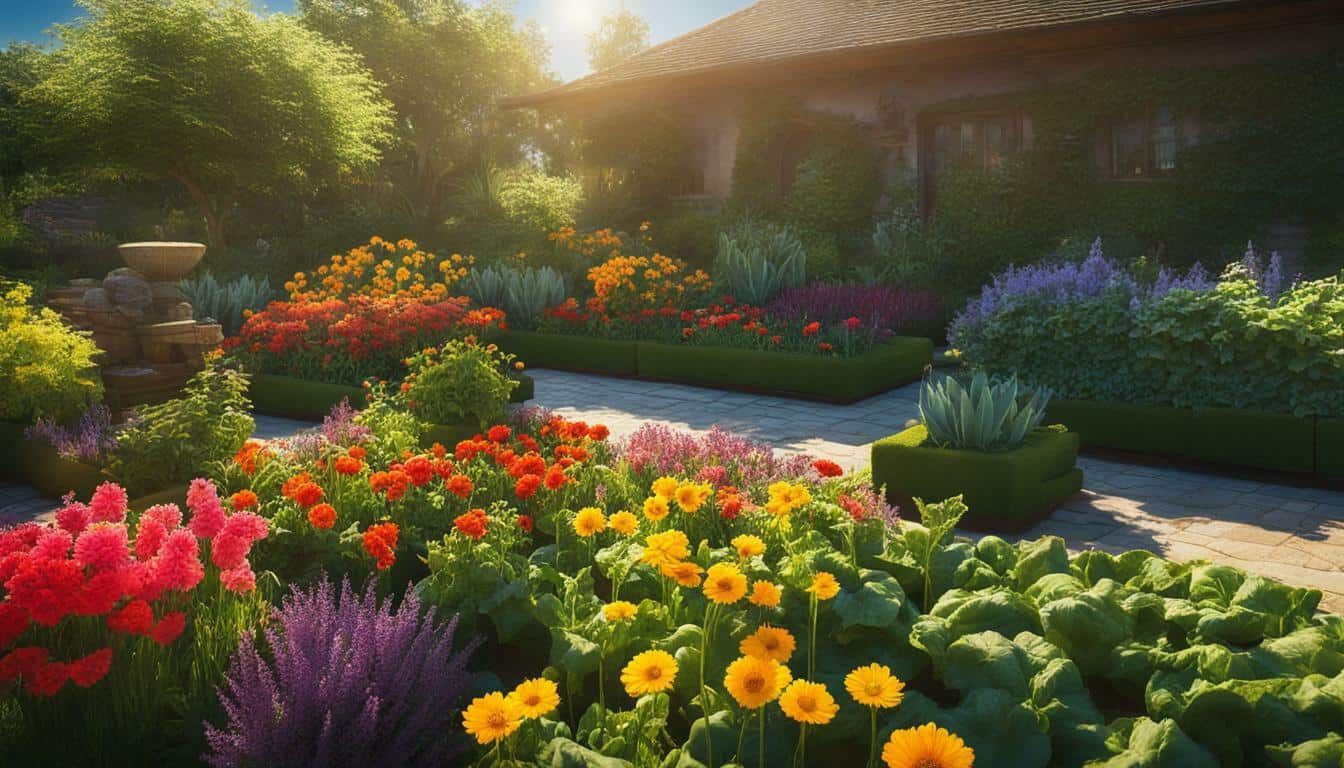



Leave a Reply